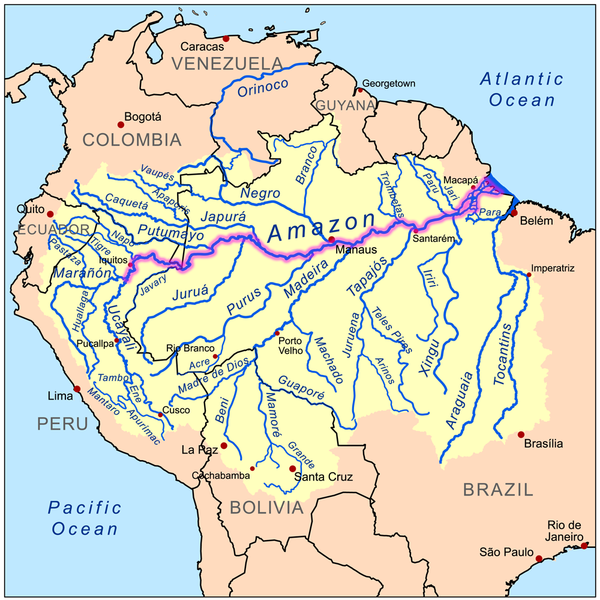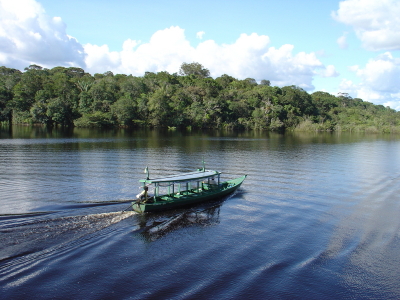I hope you've all had a happy Easter. I was out of town yesterday for the holiday, so I missed my usual Sunday post. But I'm back today.
I went to the place where I grew up, which is near lakes. The place where I live now is near lots of rivers. I've always preferred lakes to rivers, but since there are so many rivers around me now and since that's where I go to see fresh water, I thought it was high time I learned a few things about rivers.

One of the rivers near where I live.
(Photo by the Apple Lady)

Another river near where I live. Even though this looks pretty big, it's called a creek.
(Photo by the Apple Lady)

A map of rivers in the United States, with the Mississippi in red. One time in 1899, the entire Mississippi froze, from Lake Itasca to the Gulf. It stayed frozen for four days. The ice was two inches thick at New Orleans.
(Map from Science Facts)

The Amazon River basin, with the Amazon itself highlighted in purple.
(Map from Wikipedia)

Here's what the Amazon looks like from above.
(Photo from Scenery Nature)

Here's what one part of the Amazon looks like from ground level.
(Photo from Top News India)
![]()
The map on the left shows the Chicago River as it used to flow, into Lake Michigan. The map on the right shows how the Chicago Sanitary and Ship Canal connects the Chicago River to the Des Plaines River. Other channels were dug along the Calumet River to divert those into the Des Plaines, too. (Larger version of this map.)
(Map from the Great Lakes Fishery Commission, sourced from Great Lakes Guy)

Boats releasing the dye into the Chicago River
(Photo by Jennifer Roche, from About.com)

This is what the river looks like when they're done.
(Photo from Inspired Water)

Even Winnie the Pooh and Christopher Robin dropped stuff into the river.
(Image from Winnie the Pooh Prints)
Sources
Alister Doyle, World's rivers in crisis, study says, Reuters, September 29, 2010
Emma Brown, Gordon Wolman; his work transformed study of rivers, Boston Globe, March 4, 2010
American Rivers, River Facts
Minnesota Department of Natural Resources, Rivers & streams, FAQs about rivers and streams
Mississippi River Travel, River Facts & Fun
Social Studies for Kids, The 25 Longest Rivers in the World
John Roach, Amazon Longer Then Nile River, Scientists Say, National Geographic News, June 18, 2007
Sean Markey, Amazon River Once Flowed Other Way, Study Says, National Geographic News, October 25, 2006
Undercurrents: beneath the obvious, A Brief History of the Chicago Diversion, December 2, 2006
Center for Land Use Interpretation, Chicago River Lockport Gates
Linda Hall Library of Science, Engineering & Technology, Reversal of the Chicago River, Reversal of the Chicago River (2)
Chicagoist, Ask Chicagoist: River Reversal?
American Public Works Association, Top Ten Public Works of the Century, Chicago River Reversal (cached)
The Chicago River Reversal (HD video)
Chicago Green River, The Story Behind Dyeing the River
I went to the place where I grew up, which is near lakes. The place where I live now is near lots of rivers. I've always preferred lakes to rivers, but since there are so many rivers around me now and since that's where I go to see fresh water, I thought it was high time I learned a few things about rivers.

One of the rivers near where I live.
(Photo by the Apple Lady)
- The study of rivers is called potamology.
- While a creek is generally considered to be smaller than a river and "stream" may refer to either a creek or a river, in practice, "creek," "river," and "stream" are used pretty much willy nilly, regardless of a stream's size. So just because something is called a "creek," don't expect it to be small, or if it's called a "river," it could be just a trickler.

Another river near where I live. Even though this looks pretty big, it's called a creek.
(Photo by the Apple Lady)
- A river's shape is determined primarily by regular yearly floods, rather than daily currents or large catastrophic floods.
- The best way to deal with floods is not to build dams or barriers or drain swampy areas. Rather, it's best to preserve wetlands and flood plains because they absorb the overflow more effectively than any barrier could stop it.
- Currently, about 17% or 600,000 miles of United States' rivers lie behind dams.
- The Mississippi River is about 2,350 miles long. The Missouri River is actually longer, but the Mississippi is larger in terms of its flow volume.
- The Mississippi's source is Lake Itasca in Minnesota. It would take a drop of rainwater 90 days to travel the Mississippi from Lake Itasca to the Gulf of Mexico.

A map of rivers in the United States, with the Mississippi in red. One time in 1899, the entire Mississippi froze, from Lake Itasca to the Gulf. It stayed frozen for four days. The ice was two inches thick at New Orleans.
(Map from Science Facts)
- Over 300 species, or about 60% of birds in North America, use the Mississippi River as their migration pathway.
- Water skiing was invented on the Mississippi in 1922.
- The Nile, the Amazon, and the Chang Jiang (Yangtze) are the three longest rivers in the world, respectively.
- Historically, the Nile was always considered the longest river. A few years ago however, Brazilian researchers traveling the Amazon to its source added another 176 miles to its length, bringing it to a total length of 4,225 miles. That makes it 65 miles longer than the Nile.
- The Amazon currently flows west to east, but there was a time in its 11 million year-old history when the entire river flowed the other way. Researchers discovered all sorts of geological evidence bearing ripple marks and mineral traces pointing to a current that flowed east to west.

The Amazon River basin, with the Amazon itself highlighted in purple.
(Map from Wikipedia)
- The Amazon initially flowed west to east, same as it does now. But researchers think that when the land mass that is South America broke off from what is now Africa, the east coast of South America sat higher than the west, so the Amazon flowed from east to west.
- Several centuries later, when the Andes Mountains began growing, that tilted the continent the other way so that the west side was higher and the river changed its flow again, back to west-to-east.

Here's what the Amazon looks like from above.
(Photo from Scenery Nature)

Here's what one part of the Amazon looks like from ground level.
(Photo from Top News India)
- The Chicago River's direction has also changed, but that was accomplished by a team of engineers.
- The shallow and slow-moving Chicago River used to flow into Lake Michigan, but since the river was used as the dumping ground for the city's raw sewage, it all collected in the Lake.
- When 6 inches of rain fell on one day in August 1885, the existing pumping stations and sewer pipes were so overwhelmed that some 90,000 people wound up dying from cholera and typhoid fever. That was 10% of the city's population. So the city decided to deal with the sewage problem by making the river drain in the other direction, into the Mississippi River.
- It took 8 years, 70 million dollars, 56 miles of new channels dug with the aid of steam shovels and explosives, several locks along the channels, and lots of dredging of the Chicago River itself.
- The main channel, the Sanitary and Ship Canal, was cut through a low point in the continental divide to connect the Chicago River with the nearby Des Plaines River. This directed the Chicago River to empty not into Lake Michigan to the east but into the Des Plaines to the southwest.
The map on the left shows the Chicago River as it used to flow, into Lake Michigan. The map on the right shows how the Chicago Sanitary and Ship Canal connects the Chicago River to the Des Plaines River. Other channels were dug along the Calumet River to divert those into the Des Plaines, too. (Larger version of this map.)
(Map from the Great Lakes Fishery Commission, sourced from Great Lakes Guy)
- From the Des Plaines, the water would empty into the Illinois River, and from there into the Mississippi River, and finally into the Gulf of Mexico. Problem solved, the engineers said.
- The residents of St. Louis were going to go to court to stop the city from sending all their sewage down to them. When Chicago heard about St. Louis' plan, the city commissioners said that the engineers told them that by the time the water got down there, it would be clean of sewage.
- For good measure, they detonated one of the dams ahead of schedule and opened the locks before St. Louis could file their petition. Thus on January 2, 1900, the direction of the Chicago River was changed.
- Now the way Chicago likes to mess with their river is to dye it green for St. Patrick's Day. A plumber originally got the idea from the especially vivid green dye that was used to test for leaks in pipes.
- Using the plumber's idea, in 1962, the city guessed how much dye it would take. They dumped in 100 pounds of the stuff and the river stayed green for a week.
- Each year they used less and less of the dye. In 1966, they switched to a vegetable-based dye, 40 pounds of which would keep the river green for about four or five hours.
Boats releasing the dye into the Chicago River
(Photo by Jennifer Roche, from About.com)

This is what the river looks like when they're done.
(Photo from Inspired Water)
- I think all this damming and diverting and dyeing comes from some natural human impulse that, when you encounter a body of water, makes you want to play with it.
- If it's a lake, it doesn't take long until you're throwing or skipping stones into it. If it's a river, you drop sticks into it and see how long it takes them to get to travel someplace on the current. If it's a little creek, you might even get in there and start digging a channel to get it to flow someplace you think makes more sense.
- Next time you're standing next to a river or a lake, notice how little time elapses until you start messing with it.

Even Winnie the Pooh and Christopher Robin dropped stuff into the river.
(Image from Winnie the Pooh Prints)
Sources
Alister Doyle, World's rivers in crisis, study says, Reuters, September 29, 2010
Emma Brown, Gordon Wolman; his work transformed study of rivers, Boston Globe, March 4, 2010
American Rivers, River Facts
Minnesota Department of Natural Resources, Rivers & streams, FAQs about rivers and streams
Mississippi River Travel, River Facts & Fun
Social Studies for Kids, The 25 Longest Rivers in the World
John Roach, Amazon Longer Then Nile River, Scientists Say, National Geographic News, June 18, 2007
Sean Markey, Amazon River Once Flowed Other Way, Study Says, National Geographic News, October 25, 2006
Undercurrents: beneath the obvious, A Brief History of the Chicago Diversion, December 2, 2006
Center for Land Use Interpretation, Chicago River Lockport Gates
Linda Hall Library of Science, Engineering & Technology, Reversal of the Chicago River, Reversal of the Chicago River (2)
Chicagoist, Ask Chicagoist: River Reversal?
American Public Works Association, Top Ten Public Works of the Century, Chicago River Reversal (cached)
The Chicago River Reversal (HD video)
Chicago Green River, The Story Behind Dyeing the River
Nice. Ur writing reminds me of Mary Roach.
ReplyDelete